

AR apps seek to alter urban physical world. An App Puts the Twin Towers Back in Sight. Brian August stood on the roof of a building on the Greenpoint, Brooklyn, waterfront on Thursday, facing Manhattan and squinting at his iPhone in the sun.
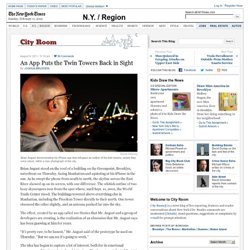
As he swept the phone from south to north, the skyline across the East River showed up on its screen, with one difference. Virtual Murals for Real-Life Buildings - Technology. If you want to paint a public mural, you will need at least several of these things: money, connections to someone who has money, a building, or permission to use someone else’s.
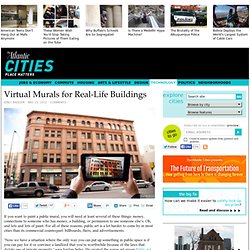
Oh, and lots and lots of paint. For all of these reasons, public art is a lot harder to come by in most cities than its commercial counterpart: billboards, fliers, and advertisements. "Now we have a situation where the only way you can put up something in public space is if you can pay for it or convince a landlord that you’re worthwhile because of the laws that dictate use of private property," says Jordan Seiler.
He created the rogue art group Public Ad Campaign, which reclaims advertising in the public realm for street art. Wallit App Assigns Virtual Walls to Physical Places. "People have wanted to leave their mark since the beginning of humanity," says Veysel Berk, creator of the mobile app Wallit.
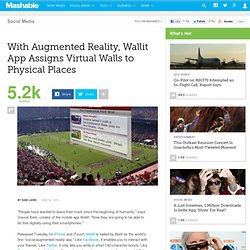
"Now they are going to be able to do that digitally using their smartphones. " Released Tuesday for iPhone and iTouch, Wallit is hailed by Berk as the world's first "social augmented reality app. " Like Facebook, it enables you to interact with your friends. Like Twitter, it only lets you write in short 140-character bursts. Like Foursquare, its digital benefits are based on where you go in the real world. The app is essentially a virtual wall for physical locations. Augmented reality brings maps to life - tech - 19 July 2005. Paper maps can be brought to life using hardware that adds up-to-the-minute information, photography and even video footage.
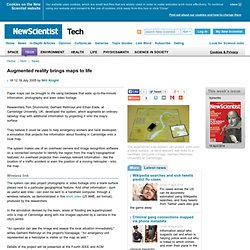
Researchers Tom Drummond, Gerhard Reitmayr and Ethan Eade, at Cambridge University, UK, developed the system, which augments an ordinary tabletop map with additional information by projecting it onto the map's surface. They believe it could be used to help emergency workers and have developed a simulation that projects live information about flooding in Cambridge onto a local map. The system makes use of an overhead camera and image recognition software on a connected computer to identify the region from the map's topographical features.
An overhead projector then overlays relevant information - like the location of a traffic accident or even the position of a moving helicopter - onto the map. Wireless link. What a Data-Rich Smart City Experience Could Really Be Like - Technology. Welcome to the "meta-city.
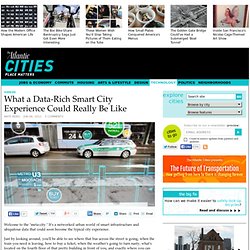
" It's a networked urban world of smart infrastructure and ubiquitous data that could soon become the typical city experience. Just by looking around, you'll be able to see where that bus across the street is going, when the train you need is leaving, how to buy a ticket, when the weather's going to turn nasty, what's located on the fourth floor of that pretty building in front of you, and exactly where you can charge your phone – likely the screen-of-choice for displaying all this information in the smart (and, it turns out, incredibly helpful) city of the future. The meta-city is visualized in this video as a "hybrid digital physical environment" where information about one's surroundings can be superimposed in real-time to create a data-rich view of the functions and actors within a city.
Explosive innovation and adoption of computing, mobile devices, and rich sources of data are changing the cities in which we live, work, and play. Image credit: frog. AR adds a new dimension to planning decisions. Planning is the source of some of the fiercest debate in public life.
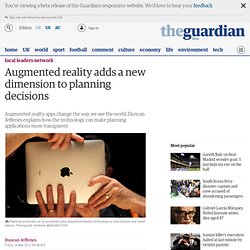
Local residents often misunderstand how a new development will look when finished, or how it will affect the surrounding area. As the diggers move in and developments begin to take shape, people start to complain that the structure doesn't resemble the artist's impression. The medium-sized building they envisaged has somehow morphed into a whacking great leisure centre that obstructs the view from their back bedroom. Street Bump: An App That Automatically Tells The City When You Drive Over Potholes.
City governments are increasingly relying on digital technology to gather data from citizens.

In San Francisco, residents can contact the city on Twitter to report potholes and graffiti. The CitySourced app lets people around the world report issues in their cities (i.e. illegal trash dumping, graffiti, etc.), as does SeeClickFix. But every solution out there requires residents to take action--snap a picture, send a Tweet, write a complaint. The Street Bump app--a collaboration between the city of Boston, The New Urban Mechanics and crowdsourcing platform Innocentive--is for the lazy among us.
Augmented Reality (AR) used in architecture and design. Augmented reality (AR) apps like Layar are not enough – soon we might see it used while designing interiors and buildings.

The possibility of how AR can be used in architecture and design can be seen in two recent examples: videos by Keiichi Matsuda, designer and film-maker, and Greg Tran, Harvard Graduate School of Design student. Matsuda’s Augmented City: 3D was a film created for his final year Masters in Architecture. While Matsuda said the video was produced over the course of a few months, it is part of a larger, ongoing independent research project called Augmented (hyper)Reality. It includes another film, Domestic Robocop, a written thesis, and a third film is currently in development. “I only started working with film a few years ago, but I found that it quickly became a really useful and quick way to explain ideas and concepts that would not be as effective in more traditional media,” he said.
Story continues below.